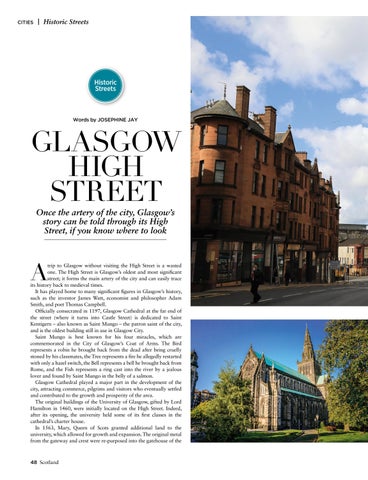CITIES
| Historic Streets
Historic Streets
Words by JOSEPHINE JAY
GLASGOW HIGH STREET Once the artery of the city, Glasgow’s story can be told through its High Street, if you know where to look
48 Scotland
© DORLING KINDERSLEY LTD/GRANGER HISTORICAL PICTURE ARCHIVE/
A
trip to Glasgow without visiting the High Street is a wasted one. The High Street is Glasgow’s oldest and most significant street; it forms the main artery of the city and can easily trace its history back to medieval times. It has played home to many significant figures in Glasgow’s history, such as the inventor James Watt, economist and philosopher Adam Smith, and poet Thomas Campbell. Officially consecrated in 1197, Glasgow Cathedral at the far end of the street (where it turns into Castle Street) is dedicated to Saint Kentigern – also known as Saint Mungo – the patron saint of the city, and is the oldest building still in use in Glasgow City. Saint Mungo is best known for his four miracles, which are commemorated in the City of Glasgow’s Coat of Arms. The Bird represents a robin he brought back from the dead after being cruelly stoned by his classmates, the Tree represents a fire he allegedly restarted with only a hazel switch, the Bell represents a bell he brought back from Rome, and the Fish represents a ring cast into the river by a jealous lover and found by Saint Mungo in the belly of a salmon. Glasgow Cathedral played a major part in the development of the city, attracting commerce, pilgrims and visitors who eventually settled and contributed to the growth and prosperity of the area. The original buildings of the University of Glasgow, gifted by Lord Hamilton in 1460, were initially located on the High Street. Indeed, after its opening, the university held some of its first classes in the cathedral’s charter house. In 1563, Mary, Queen of Scots granted additional land to the university, which allowed for growth and expansion. The original metal from the gateway and crest were re-purposed into the gatehouse of the














